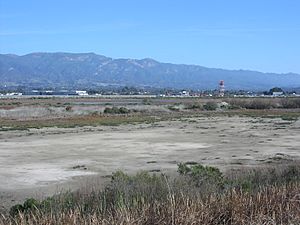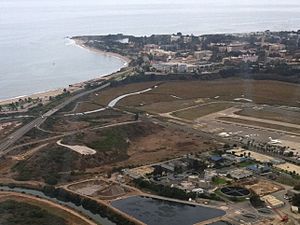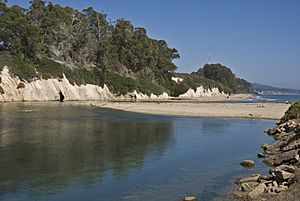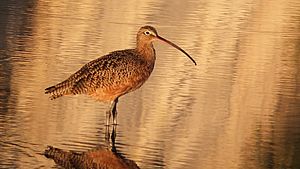Goleta Slough facts for kids
The Goleta Slough is a special natural area near Goleta, California, United States. It is a mix of watery places like estuaries, tidal creeks, and wetlands. Think of it as a big, marshy area where fresh water from creeks meets the salty ocean water. It's located about 8 miles (13 km) west of Santa Barbara.
The slough empties into the Pacific Ocean at Goleta Beach County Park. This is just east of the UCSB campus and Isla Vista. The Goleta Slough collects water from the entire Goleta Valley area. It receives water from all the main creeks that flow down from the Santa Ynez Mountains.
The Santa Barbara Airport borders a large part of the slough. In fact, the airport covers the biggest section of it. UCSB, Isla Vista, the City of Goleta, and other nearby areas also surround the slough.
Contents
How the Slough Changed
The Goleta Slough we see today is very different from how it used to be. Two big events in the late 1800s and early 1900s changed it a lot.
First, in the 1860s, many cattle grazed on the hills and mountains nearby. Then, there were big grassfires and heavy rains in 1861 and 1862. This caused a lot of dirt and mud to wash into Goleta Bay. In just a few years, most of the bay became a silt-filled salt marsh.
The second big change happened during World War II. The marsh and what was left of the bay were filled in to build a military airbase. They used parts of Mescalitan Island to fill in the area for the airport. Today, a sewage treatment plant is located where Mescalitan Island used to be.
Even though large boats can no longer use the slough, it is still very important. It has vital wetlands, salt marshes, and estuarian creeks. These areas are crucial for many plants and animals.
The Goleta Slough wetlands are spread out along the coast from More Mesa to the UCSB Storke Campus. The Goleta Slough Ecological Reserve is a protected area. It has about 430 acres (1.7 square kilometers) of wetland habitat. This includes a 360-acre (1.5 square kilometers) ecological reserve.
The main purpose of the Ecological Reserve is to provide a home for wildlife. It is also a place for education and research. Some roads, airport runways, a sewage treatment plant, and other buildings are on parts of the marsh that were filled in.
History of the Area
People have lived in the Goleta Slough area for a very long time. Native American peoples started living here about 9,000 years ago. Early European explorers used the bay as a place for large ships to anchor until the 1860s.
After the big storms of 1861-1862 filled the bay with mud, farming began in the slough area in the 1870s. Farmers built berms, levees, and roads to help with farming. In 1928, a landing strip was built in the slough. This strip was made much bigger in 1942-1943 to build the Marine Corps Air Station. This is now the Santa Barbara Municipal Airport. The Marine station was called Marine Corps Air Station Santa Barbara and closed in 1946.
Surrounding Areas
The Goleta Slough is almost completely surrounded by towns and cities. Some of these developments even extend into the wetlands. For example, the municipal airport is to the north. A sewage treatment plant and a gas field are to the east. A public beach is between the ocean and the slough. The UCSB campus is to the south and west. Homes and light industrial businesses are to the north and west.
In the past, people used the land around the slough for different things. Cattle ranching started in 1846. Then, farming began on the higher lands. A whaling station was set up around 1870. People also mined for asphaltum in the 1890s. Small farms grew to cover the entire area in the 1920s. Then, many more buildings and towns started to appear rapidly in the 1940s.
Water Flow and Tides
Many parts of the historic marsh are now cut off from the ocean's tides by berms and dikes. This means the ocean's high tide only reaches certain parts of the slough. During the summer, the tides might not reach as far into the slough. This happens because sand can build up at the mouth of the slough. Workers sometimes use machines to open the beach berm. This helps keep the water quality good in the slough.
The slough gets its water from a large area of 45 square miles (117 square kilometers). This is called its watershed.
The main creeks that flow into the slough are Tecolotito Creek, Carneros Creek, and Atascadero Creek. Tecolotito Creek flows strongest during winter storms. In the summer, it sometimes dries up. Carneros Creek often has flash floods during storms and sometimes dries up in summer. Atascadero Creek usually has fresh water flowing all year. This flow increases during winter storms. Other water sources include runoff from the bluffs of the UCSB campus and More Mesa.
Habitats in the Slough
The Goleta Slough has many different types of habitats for plants and animals. Here are some of them:
- Coastal Salt Marsh: 101 acres (409,000 square meters) of marsh where salty water from the ocean mixes with fresh water.
- Mudflats: 15 acres (61,000 square meters) of muddy areas, often exposed at low tide.
- Saltflats: 4 acres (16,000 square meters) of flat, salty ground.
- Creeks and Channels: 28 acres (113,000 square meters) of flowing water paths.
- Riverine (Riparian) Areas: Over 8 acres (32,000 square meters) of land along the creeks.
- Palustrine (Vernal Wetlands): 198 acres (801,000 square meters) of wetlands that are wet seasonally.
- Scrub/Shrub and Forested Wetlands: 4.5 acres (18,000 square meters) with bushes and trees in wet areas.
Plants of the Slough
The Goleta Slough is home to many different plants. Some common plants found here include:
- Pickleweed
- Alkali-heath
- Salt grass
- Jaumea
- Salt bush
- Ditch-grass
- Pondweed
- Tule
- Cattails
You can also find shrubs like willows and coyote brush. The main trees in the area are southern coastal oaks.
Animals of the Slough
Many different animals live in or use the Goleta Slough wetlands. These include birds, fish, tiny creatures called benthic invertebrates, insects, and other wildlife.
Birds of the Slough
A lot of different birds visit the Goleta Slough. About 279 types of birds have been seen there! Out of these, 121 are water-associated birds, and 20 of them are considered "special status" species (meaning they need extra protection).
Fish of the Slough
In a study from 1993, 10 types of fish were found in the slough. The most common ones were Killifish, Topsmelt, Arrow goby (Clevelandia ios), and Western mosquitofish (Gambusia affinis). In 1995, a Steelhead trout (Oncorhynchus mykiss) that was ready to lay eggs was found in Tecolotito Creek.
Tiny Creatures and Insects
The slough has many small creatures without backbones. These include different types of polychaetes (a type of worm) and bivalves (like clams). Other common tiny animals include the lined shore crab, yellow shore crab, and California horn snail.
Surveys in 1993 found 11 types of insects in the slough. The main groups were bugs, damselflies, mayflies, beetles, caddisflies, butterflies, and flies.
Other Wildlife
Studies in the 1980s and 1990s found other animals like two types of mice, one vole, one amphibian, and two types of reptiles. The Western pond turtle (Actinemys marmorata) was seen in Atascadero Creek.
Some special mammals identified in the slough include the Pallid bat (Antrozous pallidus), American badger (Taxidea taxus), and the San Diego black-tailed jackrabbit (L. californicus bennettii). In 1970, ten different types of mammals were found in the main part of the slough.
Special Status Species
Many animals in the Goleta Slough are considered "special status species." This means they are rare or their populations are decreasing, so they need protection. A report from 1996 listed 20 such bird species. These include:
- California brown pelican
- Southern bald eagle
- Peregrine falcon
- Snowy plover
- Common loon
- American white pelican
- Double-crested cormorant
- White-faced ibis
- Fulvous whistling duck
- Harlequin duck
- Northern harrier
- Golden eagle
- Osprey
- Long-billed curlew
- California gull
- Elegant tern
- Black skimmer
Other special birds seen more recently include Belding's Savannah sparrow (1994) and California horned lark (1995).
The 1996 report also mentioned special status mammals seen in 1983: the Pallid bat, American badger, and the San Diego black-tailed jackrabbit.







